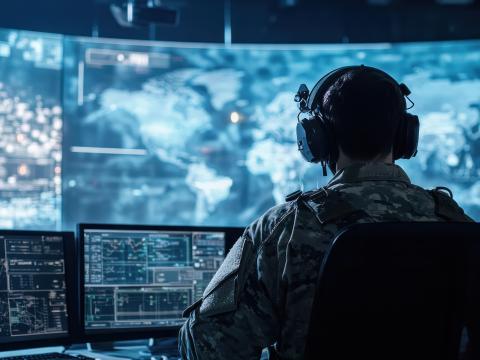Data Remains Key to Military Artificial Intelligence Strategy
With the exponential jump in available data from the increase in digital solutions and sensors, the U.S. Department of Defense continues to advance its data and analytical capabilities. This includes the increased integration of artificial intelligence (AI) into military operations, as well as a $1.8 billion investment in AI and machine learning capabilities over the coming fiscal year.
To guide its next steps, the department yesterday released its 2023 DOD Data, Analytics, and AI Adoption Strategy, presented by Deputy Secretary of Defense Kathleen Hicks to reporters at the Pentagon, followed by a briefing from the department’s chief digital and AI officer, Craig Martell, whose office prepared and will implement the plan.
Hicks emphasized that the United States was not in ‘an AI’ race with China and that any use of AI by the DoD would be responsible, meet international norms and continue to include human oversight ‘in-the-loop.’
“This is a topic we care a lot about at DoD, and we've been working on it for quite some time, for not only is AI on the minds of many Americans today, it's a key part of the comprehensive warfighter-centric approach to innovation that Secretary [Lloyd] Austin and I have been driving from day one,” she stated.
Since much of the innovation is happening outside the DoD and government, the military is striving to adopt advancements “wherever they can add the most military value.” Industry solutions related to generative AI, however, are not quite advanced enough to meet military standards, Hicks said.
“Candidly, most commercially available systems enabled by large language models aren't yet technically mature enough to comply with our ethical AI principles, which is required for responsible operational use,” she offered. “But we have found over 180 instances where such generative AI tools could add value for us with oversight.”
Under the plan, the DoD will leverage solutions from the national laboratories and academia, in addition to the industry, as part of its drive to become a more modernized, data-driven and AI-empowered military.
“In DoD, we always succeed through teamwork, and here, we're fortunate to work closely with a strong network of partners in national labs, universities, the intelligence community, traditional defense industry, and also, nontraditional companies in Silicon Valley and hubs of AI innovation all across the country,” the deputy secretary said. “In several of those, we're physically present, including through offices of the Defense Innovation Unit, which we recently elevated to report directly to the secretary.”
Candidly, most commercially available systems enabled by large language models aren't yet technically mature enough to comply with our ethical AI principles, which is required for responsible operational use. But we have found over 180 instances where such generative AI tools could add value for us with oversight.
The military is looking for AI-related solutions for tactical application that help accelerate the speed of commander decisions and improve the quality and accuracy of decisions. The department is also seeking AI to aid in managing its enterprise, “since our vast scale can make it difficult for DoD to see itself clearly, spot problems and solve them, leveraging data,” Hicks explained. “AI can help leaders make choices that are smarter, faster and even lead to better stewardship of taxpayer dollars.”
Naturally, AI solutions are only effective with quality data inputs. The department posits that the data decrees leaders have issued to make all DoD data visible, accessible, understandable, linked, trustworthy, interoperable and secure will improve the quality, as will the data scientists employed at every combatant command and the Joint Warfighting Cloud Capability to provide computing, storage, network infrastructure and advanced data analytics to scale on demand. “We are integrating sensors, infusing data across every domain, while leveraging cutting-edge decision support tools to enable high-op tempo operations,” she noted.
Hicks hopes that the plan will help the military achieve its concept of combined joint all-domain command and control, CJADC2, to include partners and allies in the strive for connecting all sensors to shooters in any warfighting domain. “To be clear, CJADC2 isn't a platform or single system we're buying,” she said. “It's a whole set of concepts, technologies, policies and talent that are advancing a core U.S. warfighting function, the ability to command and control forces.
“And our policy for autonomy in weapons systems is clear and well established,” the deputy secretary emphasized. “There is always a human responsible for the use of force, full stop. Unlike some of our strategic competitors, we don't use AI to sensor, constrain, repress or disempower people. By putting our values first and playing to our strengths, the greatest of which is our people, we've taken a responsible approach to AI that will ensure America continues to come out ahead.”





Comments